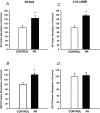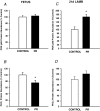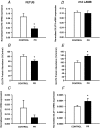The transition from fetal growth restriction to accelerated postnatal growth: a potential role for insulin signalling in skeletal muscle
- PMID: 19622603
- PMCID: PMC2754360
- DOI: 10.1113/jphysiol.2009.173161
The transition from fetal growth restriction to accelerated postnatal growth: a potential role for insulin signalling in skeletal muscle
Abstract
A world-wide series of epidemiological and experimental studies have demonstrated that there is an association between being small at birth, accelerated growth in early postnatal life and the emergence of insulin resistance in adult life. The aim of this study was to investigate why accelerated growth occurs in postnatal life after in utero growth restriction. Samples of quadriceps muscle were collected at approximately 140 days gestation (term approximately 150 days gestation) from normally grown fetal lambs (Control, n = 7) and from growth restricted fetal lambs (placentally restricted: PR, n = 8) and from Control (n = 14) and PR (n = 9) lambs at 21 days after birth. The abundance of the insulin and IGF1 receptor protein was higher in the quadriceps muscle of the PR fetus, but there was a lower abundance of the insulin signalling molecule PKC, and GLUT4 protein in the PR group. At 21 days of postnatal age, insulin receptor abundance remained higher in the muscle of the PR lamb, and there was also an up-regulation of the insulin signalling molecules, PI3Kinase p85, Akt1 and Akt2 and of the GLUT4 protein in the PR group. Fetal growth restriction therefore results in an increased abundance of the insulin receptor in skeletal muscle, which persists after birth when it is associated with an upregulation of insulin signalling molecules and the glucose transporter, GLUT4. These data provide evidence that the origins of the accelerated growth experienced by the small baby after birth lie in the adaptive response of the growth restricted fetus to its low placental substrate supply.
Figures




Similar articles
-
Placental restriction reduces insulin sensitivity and expression of insulin signaling and glucose transporter genes in skeletal muscle, but not liver, in young sheep.Endocrinology. 2012 May;153(5):2142-51. doi: 10.1210/en.2011-1955. Epub 2012 Mar 20. Endocrinology. 2012. PMID: 22434080
-
Postnatal effects of intrauterine treatment of the growth-restricted ovine fetus with intra-amniotic insulin-like growth factor-1.J Physiol. 2018 Dec;596(23):5925-5945. doi: 10.1113/JP274999. Epub 2017 Dec 27. J Physiol. 2018. PMID: 29235113 Free PMC article.
-
Fetal growth restriction, catch-up growth and the early origins of insulin resistance and visceral obesity.Pediatr Nephrol. 2010 Apr;25(4):669-77. doi: 10.1007/s00467-009-1407-3. Epub 2009 Dec 22. Pediatr Nephrol. 2010. PMID: 20033220 Review.
-
Cardiac programming in the placentally restricted sheep fetus in early gestation.J Physiol. 2024 Aug;602(15):3815-3832. doi: 10.1113/JP286702. Epub 2024 Jul 8. J Physiol. 2024. PMID: 38975864
-
Altered fetal skeletal muscle nutrient metabolism following an adverse in utero environment and the modulation of later life insulin sensitivity.Nutrients. 2015 Feb 12;7(2):1202-16. doi: 10.3390/nu7021202. Nutrients. 2015. PMID: 25685986 Free PMC article. Review.
Cited by
-
Augmented glucose production is not contingent on high catecholamines in fetal sheep with IUGR.J Endocrinol. 2021 May 13;249(3):195-207. doi: 10.1530/JOE-21-0071. J Endocrinol. 2021. PMID: 33994373 Free PMC article.
-
Intrauterine growth-restricted sheep fetuses exhibit smaller hindlimb muscle fibers and lower proportions of insulin-sensitive Type I fibers near term.Am J Physiol Regul Integr Comp Physiol. 2016 Jun 1;310(11):R1020-9. doi: 10.1152/ajpregu.00528.2015. Epub 2016 Apr 6. Am J Physiol Regul Integr Comp Physiol. 2016. PMID: 27053651 Free PMC article.
-
Early restriction of placental growth results in placental structural and gene expression changes in late gestation independent of fetal hypoxemia.Physiol Rep. 2016 Dec;4(23):e13049. doi: 10.14814/phy2.13049. Physiol Rep. 2016. PMID: 27923976 Free PMC article.
-
Differential effects of late gestation maternal overnutrition on the regulation of surfactant maturation in fetal and postnatal life.J Physiol. 2017 Nov 1;595(21):6635-6652. doi: 10.1113/JP274528. Epub 2017 Aug 24. J Physiol. 2017. PMID: 28759122 Free PMC article.
-
Normalisation of surfactant protein -A and -B expression in the lungs of low birth weight lambs by 21 days old.PLoS One. 2017 Sep 26;12(9):e0181185. doi: 10.1371/journal.pone.0181185. eCollection 2017. PLoS One. 2017. PMID: 28949968 Free PMC article.
References
-
- Albertsson-Wikland K, Wennergren G, Wennergren M, Vilbergsson G, Rosberg S. Longitudinal follow-up of growth in children born small for gestational age. Acta Paediatr. 1993;82:438–443. - PubMed
-
- Aldermann GA, Morgan DE, Harvard A, Edwards RE, Todd JR. Ministry of Agriculture, Fisheries and Food: Technical Bulletin 33. London: Her Majesty's Stationery Office; 1975. Energy allowances and feeding systems for ruminants; pp. 34–36.
-
- Arai T, Washizu T, Sagara M, Sako T, Nigi H, Matsumoto H, Sasaki M, Tomoda I. D-Glucose transport and glycolytic enzyme activities in erythrocytes of dogs, pigs, cats, horses, cattle and sheep. Res Vet Sci. 1995;58:195–196. - PubMed
-
- Barker DJP. Fetal and Infant Origins of Adult Disease. London: British Medical Journal Publishing Group; 1992.
-
- Bavdekar A, Yajnik C, Fall C, Bapat S, Pandit A, Deshpande V, Bhave S, Kellingray S, Joglekar C. Insulin resistance syndrome in 8-year-old Indian children: small at birth, big at 8 years, or both? Diabetes. 1999;48:2422–2429. - PubMed
Publication types
MeSH terms
Substances
Grants and funding
LinkOut - more resources
Full Text Sources
Medical
Research Materials
Miscellaneous

